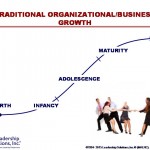| 21st Century Business Ideas |
by Peter A. Arthur-Smith, Leadership Solutions, Inc.®
“Progress is impossible without change,” wrote George Bernard Shaw, “and those who cannot change their minds cannot change anything.”
Think of Staples, Google, Microsoft, Facebook and Whole Foods: all enterprises that burst onto the national and international scene within a few short years. What did they all have in common? They were all willing to change and adapt – and rapidly in some instances – in order to exploit opportunities within their respective marketplaces.
Wall Street is all about “making money,” be that through investing, equity plays, mezzanine financing, and buying and selling businesses. All have their place but they still rely on two things to make them work – effective leadership and management. Question is: which one has the greatest impact on change and seizing the rapid growth opportunities the above headline companies accomplished?
Management, at its best, is all about minimizing risk and fine-tuning a team or organization. It’s often slow to embrace change in its desire for efficiency. Stability and process become the order of the day, which, although are quite necessary along the way, can also become the antithesis of growth. Management tends to focus on today at the expense of tomorrow. Organizations that are well managed are usually profitable, but too often don’t go very far, very fast.
On the other hand, leadership does embrace change and opportunity. It pursues maximum growth and looks toward the future more so than keeping an eye on the day-to-day. It constantly seeks to position and re-position its enterprise for future growth and rapid development. Taking the next step or entering the next phase is always “top-of-the-mind.”
So, as much as management is important to efficient handling of the day-to-day, leadership is the vital ingredient for constant growth and scale. Even so, that leadership has to evolve through five phases of significant enterprise growth: Start-up, Critical Mass, Rapid Growth, Strategic Growth, and Self-renewing Growth.
- Start-up – Traditionally this is when one or two business people see an opportunity that their current organization doesn’t see or wish to pursue. Founders go off full of confidence and determination to prove their idea was right and are willing to endure the personal and financial sacrifices to do so. However, this traditional reliance on an entrepreneurial founder(s) is a wasteful approach in this day and age. 70% or more of entrepreneurial start-ups fail or don’t go anywhere fast. Of the remaining 30% or less, many are picked-off within a few short years by larger predators that don’t have the entrepreneurial spark to incubate their own enterprises. Such enterprise teams, consisting of full-time, part-time or voluntary participation among seven players, will reach the critical mass stage much quicker for many reasons. Without them, the pathway, without some luck, can be awfully painful and slow. Pulling together and orchestrating such a team is a vital test for a start-up visionary leader. 80% of start-up people don’t have such talents, or marginal at best, which is why so many start-ups fail.
- To adopt such a team concept will mean entrepreneur types giving-up their traditional idea of keeping all the equity and profits to themselves. It will also mean founders not automatically reserving visionary leader spots for themselves because they may not have the team leader skills to match. They’d be better off ceding that to a colleague and taking one of the other six positions, where they’re better suited… this takes courage, maturity and a sense of reality.
- It’s this writer’s firm belief that the traditional start-up approach is dead both for now and the future. Instead, founders would be better off by utilizing an enterprise team which consists of seven players: a visionary leader, expansionist, innovationist, resource facilitator, operationist, promoter, and devil’s advocate. Why a “devil’s advocate” might you ask? Because every enterprise team needs someone to question and encourage team members to adjudicate their reality and passion toward current strategies and future vision. (Note: This writer thinks of a current robot enterprise that is rushing to market without fully contemplating some of the push-back it’s likely to experience.)
- A high proportion fail because they don’t have the requisite leadership and/or organizational skills to make it work. Another portion limp along for the same reasons or their market is not ready for their products or services – despite their validity. Sometimes a market has to be educated before it is ready to consume. Hence timing is critical, too.
- To learn more about these five growth phases, talk with: (Part 2 – next edition in 2 weeks)

